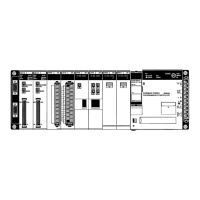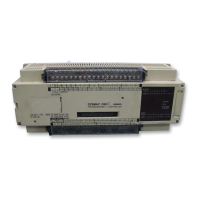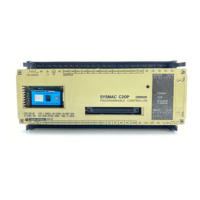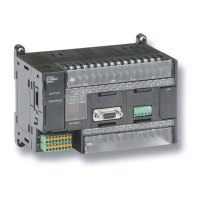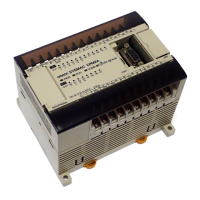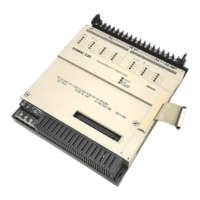60
3-7 HR (Holding Relay) Area
The HR area is used to store/manipulate various kinds of data and can be ac-
cessed
either by word
or by bit. W
ord addresses range from HR 00 through HR
99;
bit addresses, from HR 0000 through
HR 9915. HR bits can be used in any
order required and can be programmed as often as required.
The
HR area retains status when the system
operating mode is changed, when
power is interrupted, or when PC operation is stopped.
HR
area
bits and words can be used to preserve data whenever PC operation is
stopped.
HR bits also have various special applications, such
as creating latch
-
ing relays with the Keep instruction and
forming self-holding outputs. These are
discussed
in
Section
4 Writing and Inputting the Program
and
Section
5 Instruc
-
tion Set.
Note The
required number of words is allocated between HR 00 and HR 42 for
routing
tables and to monitor timers when using SYSMAC NET Systems.
3-8 TC
(T
imer/Counter) Area
The
TC
area is used to create and program timers and counters and holds the
Completion flags, set values (SV), and present values (PV) for all timers and
counters.
All of these are accessed through TC numbers ranging
from TC 000
through
TC
51
1. Each TC number is defined as either a timer or counter using
one
of the following instructions: TIM, TIMH, CNT
, CNTR(12), and TTIM(87). No
prefix is required when using a TC number in a timer or counter instruction.
Once
a TC number has
been defined using one of these instructions, it cannot
be redefined elsewhere in the program either using the same or a different in-
struction. If the same TC number is defined in more than one of these instruc-
tions
or in the same instruction twice, an error will be generated during the pro
-
gram
check. There are no restrictions on the order in which TC numbers can be
used.
Once defined, a TC number
can be designated as an operand in one or more of
certain
set of instructions other than those listed above. When defined as a timer
,
a TC number designated as an operand takes a TIM prefix. The TIM prefix is
used
regardless of the timer instruction that was used to define
the timer
. Once
defined as a counter, the TC number designated as an operand takes a CNT
prefix.
The CNT is also
used regardless of the counter instruction that was used
to define the counter.
TC
numbers can be designated for operands that require bit data
or for operands
that
require word data.
When designated as an operand that requires bit data,
the
TC number accesses the completion flag of the timer or counter
. When des
-
ignated
as an operand that requires word data, the TC number accesses a
mem
-
ory location that holds the PV of the timer or counter.
TC
numbers are also used to access the SV of timers and counters from a Pro
-
gramming
Device. The procedures
for doing so using the Programming Console
are provided in 7-1 Monitoring Operation and Modifying Data.
The
TC area retains the SVs of both timers and counters during power interrup
-
tions.
The PVs of timers are reset when PC operation is begun and when reset in
interlocked program sections. Refer to 5-10 INTERLOCK and INTERLOCK
CLEAR
– IL(02) and ILC(03)
for details on timer and counter operation in inter
-
locked program sections. The PVs of counters are not reset at these times.
Note
that in programming “TIM 000” is used to designate three things: the T
imer
instruction defined with TC number 000, the completion flag for this timer
, and
the
PV of this timer
. The meaning in context should
be clear
, i.e., the first is al
-
ways an instruction, the second is always a bit, and the third is always a word.
The same is true of all other TC numbers prefixed with TIM or CNT.
TC Area Section 3-8
